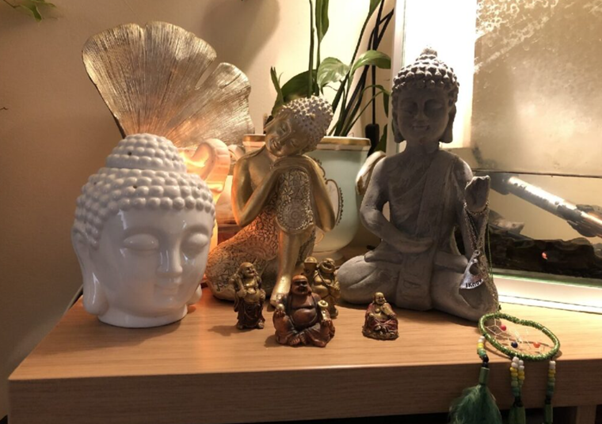Digital Photography and Multi-Sensory Learning Online

How can we encourage online learners to engage with their local and physical environment beyond their computer screens? There is increasing evidence of the benefits of object-based and multi-sensory learning at all levels of education (including higher education) as a way of supporting student engagement and deep, personalised learning (see, for example, Chatterjee and Hannan, eds., 2015). These benefits do not just apply to subject disciplines that rely explicitly on hands-on experiences, field work, lab experiments or placements. Multisensory learning can also help students come to grips with complex theoretical concepts in any subject discipline in the Arts and Social Sciences (and beyond). However, how can this be facilitated in online and distance learning environments?
These questions were important to colleagues in the Department of Religious Studies here at the Open University when we designed the module ‘A227 Exploring Religion: Places, Practices, Texts and Experiences’. This module introduces students to the study of religion, with the aim of helping them understand ‘religion’ not just in terms of abstract beliefs, but as it is ‘lived’ and expressed through objects, places, sounds, smells, tastes, and practices. We were looking for ways to actively and creatively engage students in their learning and help them work out how the concepts they are learning about could be relevant and applicable to their own local environment.
To support the critical discussion of different definitions of the concept of ‘religion’, we decided to ask students to take and share photographs of an object or a place (human-made or natural) that expresses something interesting about what religion ‘is’. Students are free to take/select an image of something which may not conventionally be understood as ‘religion/religious’, but that raises questions about the possible blurring of boundaries between the ‘religious’ and the ‘secular’. Students are encouraged to be creative (whilst being mindful of privacy and copyright issues). We ask them to upload their images onto a digital pinboard (we used an inhouse Open University platform called ‘OpenStudio’ – though there are many other platforms that can be used for the same purpose), along with a brief image description and a comment on why they chose this picture. We also ask students to comment on at least one other student’s contribution to the pinboard. While this activity is not assessed as such, it is linked to a two-part assignment requiring students to (a) discuss how the image they selected for this activity addresses the question ‘What is religion?’ (engaging with definitions and debates they have been introduced to in the module materials) and (b) reflect on their experience of this activity. This is followed by two further unassessed activities using the digital pinboard. One of these activities is asking students to share images of objects or buildings in their local neighbourhood that reflect urban and religious change (such as religious buildings which had changed use and become secular, or vice-versa). Another invites students to make, share and comment on sound recordings, reflecting on the role that sound can have in religious experiences.
In order to get a better sense of how students and tutors experienced these activities, we sent out a survey to students, interviewed tutors and analysed contributions to the digital pinboard as well as assignment submissions (with the students’ permission). My colleague John Maiden and I published the findings of this study in two articles that are available as Open Access publications. Our paper on ‘Personalised and multi-sensory approaches to engaging students at a distance: A case study from Religious Studies’ (2018) explores the strengths and limitations of the way in which these activities use digital technologies to facilitate personalised, multisensory learning. Our article ‘Take a picture of religion: Engaging students in the multisensory study of lived religion’ (2020), on the other hand, focuses on how this pedagogic approach addresses issues of particular relevance to the study of religion in higher education.
Our project findings are of particular relevance to online and distance learning settings, where opportunities for object-based and multisensory learning are relatively underexplored. However, they can be applied to a wide range of settings and will be of interest to anyone looking for creative ways to engage students in the Arts and Social Sciences (and possibly beyond)! To show you some examples of the kind of contributions students have made to these activities, some of this year’s 227 students have kindly agreed to share photographs here that they used for the ‘Take a picture of religion’ activity.

‘Livestreamed church service’, photograph by A227 student Jude Taylor

‘Wudu area on the Open University campus’, photograph by A227 student Jo Clarke

‘Journalling Bible’, photograph by A227 student Cerys Wood

‘Collection of Buddhas’, photograph by A227 student Helen Harman-Freer

‘Rosary by my bedside’, photograph by A227 student Lisa-Marie Donohue

‘Truro’, photograph by A227 student Joel Absalom

‘St Peter’s church’, photograph by A227 student Helen Harman-Freer
References:
Chatterjee, H. and Hannan, L. (eds) (2015) Engaging the Senses: Object-based Learning in Higher Education, Abingdon/ New York, Ashgate.
Maiden, John and Sinclair, Stefanie (2018) ‘Personalised and multi-sensory approaches to engaging students at a distance: A case study from Religious Studies’ in Josep M. Duart and András Szűcs (eds) Towards Personalized Guidance and Support for Learning, Proceedings of the 10th European Distance and E-Learning Network Research Workshop, EDEN, Barcelona, pp. 261-269. ISBN 978-615-5511-25-7 [Online] https://proceedings.eden-online.org/wp-content/uploads/2018/11/RW10_2018_Barcelona_Proceedings_ISSN.pdf
Sinclair, S. and Maiden, J. (2020) ‘Take a picture of religion: Engaging students in the multisensory study of religion’, JBASR: Journal of the British Association for the Study of Religions, Vol. 22 (Visualising Cultures), pp. 122-37. [Online] https://doi.org/10.18792/jbasr.v22i0.51
